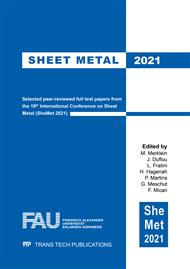[1]
A.T. Beyene, E.G. Koricho, G. Belingardi, B. Martorana. Design and manufacturing issues in the development of lightweight solution for a vehicle frontal bumper. Procedia Engineering 88 (2014) 77-84.
DOI: 10.1016/j.proeng.2014.11.129
Google Scholar
[2]
Xiaobing Dang, Kai He, Feifei Zhang, Qiyang Zuo, Ruxu Du. Multi-stage incremental bending to form doubly curbed plates based on bending limit diagram. International Journal of Mechanical Sciences 155 (2019) 19-30.
DOI: 10.1016/j.ijmecsci.2019.02.001
Google Scholar
[3]
G. Ambrogio, L. De Napoli, L. Filice, F. Gagliardi, M. Mazzupappa. Application of incremental forming process for high customized medical product manufacturing. Journal of Material Processing Technology 162-163 (2005) 156-162.
DOI: 10.1016/j.jmatprotec.2005.02.148
Google Scholar
[4]
A. Attanasio, E. Ceretti, C. Giardini, L. Mazzoni. Asymmetric two points incremental forming: Improving surface quality and geometric accuracy by tool path optimization. Journal of material process technology 197 (2008) 59-67.
DOI: 10.1016/j.jmatprotec.2007.05.053
Google Scholar
[5]
J. Jeswiet, F. Micari, G. Hirt, A. Bramley, J. Duflou, J. Allwood. Asymmetric single point incremental forming of sheet metal. CIRP Annals Volume 54, Issue 2 (2005) 88-114.
DOI: 10.1016/s0007-8506(07)60021-3
Google Scholar
[6]
W.C. Emmens, G. Sebastianini, A.H. van den Boogaard. The technology of incremental sheet forming – A brief review of the history. Journal of Materials processing technology 210 (2010) 981-997.
DOI: 10.1016/j.jmatprotec.2010.02.014
Google Scholar
[7]
C.T. Wang, G. Kinzel, T. Altan. Failure and wrinkling criteria and mathematical modeling of shrink and stretch flanging operations in shett-metal forming. Journal of materials processing technology 53 (1995) 759-780.
DOI: 10.1016/0924-0136(94)01766-t
Google Scholar
[8]
H. Voswinckel, M. Bambach, G. Hirt. Process limits of stretch and shrink flanging by incremental sheet metal forming. Key engineering materials vol. 549 (2013) 45-52.
DOI: 10.4028/www.scientific.net/kem.549.45
Google Scholar
[9]
H. Voswinckel, M. Bambach, G. Hirt. Improving geometrical accuracy for flanging by incremental sheet metal forming. Int J Mater form (2015) 8 391-399.
DOI: 10.1007/s12289-014-1182-y
Google Scholar
[10]
T. Buranathiti, J. Cao, W. Chen, L. Baghdasaryan, Z. Cedric Xia. Approaches for Model Validation: Methodology and Illustration on a Sheet Metal Flanging Process. J. Manuf. Sci. Eng. (2006) 128(2) 588-597.
DOI: 10.1115/1.1807852
Google Scholar
[11]
N. Le Maoût, S. Thuillier, P.Y. Manach. Classical and Roll-hemming Processes of Pre-strained Metallic Sheets. Experimental Mechanics (2010) 50 1087–1097.
DOI: 10.1007/s11340-009-9297-7
Google Scholar
[12]
J.Q. Wang, Y.W. Huang, G.R. Zhou, Z.L Niu, Z.W. Cheng. Process Parameters Study on Robot Rope Hemming of the Hood.Applied Mechanics and Materials (2014) 950–953.
DOI: 10.4028/www.scientific.net/amm.602-605.950
Google Scholar
[13]
X. Hu, Y.X. Zhao, S.H. Li, C. Liu. Numerical Simulation of Dimensional Variations for Roller Hemming. Advanced Materials Research (2010),160-162 1601–1605.
DOI: 10.4028/www.scientific.net/amr.160-162.1601
Google Scholar
[14]
T. Kleeh, M. Merklein, K. Roll. Modeling Laser Heating for Roller Hemming Applications. Key Engineering Materials (2011) 473 501–508.
DOI: 10.4028/www.scientific.net/kem.473.501
Google Scholar


